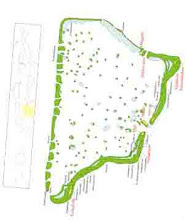 I close my Spanish tour with my visit to the Medina Azahara, the last Islamic wonder. About fifteen kilometers to the North West of the city of Cordoba, at the end of a narrow country road, in the foothills of the mountains, there are the ruins of an ancient palatial and administrative city built by the first Caliph of Al Andalus, Abdel Rahman III, beginning in 963 AD. Medina Azahara, spanisation of the Arab name Madīnat al-Zahr ā ' (The city of Zahra) was a city when western direction told palace to be built by Abderramán III (Abd al-Rahman III, al-Nasir). The principal causes of his construction were of nature ideological-politician: The dignity of the Calif demands the foundation of a new city, symbol of his power, to the imitation of other oriental caliphates and especially, to show his superiority on his great enemies, the fatimíadas of Ifriqia, the Northern District of the African continent. In spite of the wealth and solidity of the employed materials, Medina Azahara did not come surviving not even one century, since I was destroyed and looted in 1010, like consequence of the civil war that put end to the caliphate of Cordoba. There are many interesting legends surrounding this city, which in its short life was renowned as the most luxurious and artistically pleasing city in Europe, outshining even Cordoba. Built as the administrative capital of Muslim Spain, it was destroyed only about forty five years after it was begun, by mutinous Berber soldiers, angered by its luxury. The ruins were abandoned and plundered; it is said that some of the marble columns now are evident in the facade of the Giralda in Sevilla. The city was eventually buried by the dust and mud from the adjacent mountains of the Sierra Morena. After almost a thousand years of silence, the ruins began to be excavated in 1910, but even today only a fraction of the enormous site has been cleared. The site is called Madinat al Zahra: the city of blossoms. The word comes from the word azahar means white flower, particularly the blossom of orange or lemon, and that it comes from the arabic al zahr, meaning the same. The perfume of orange blossom fills the evening air in Sevilla in the summer; and it was in Sevilla that we first thought about forming Azahar. Another possible, and perhaps more likely, source for the name is that he named it after the daughter of Muhammad, who was called Fatima Az Zahra (the shining one), and thus the name would be the Islamic equivalent of Marysville.
I close my Spanish tour with my visit to the Medina Azahara, the last Islamic wonder. About fifteen kilometers to the North West of the city of Cordoba, at the end of a narrow country road, in the foothills of the mountains, there are the ruins of an ancient palatial and administrative city built by the first Caliph of Al Andalus, Abdel Rahman III, beginning in 963 AD. Medina Azahara, spanisation of the Arab name Madīnat al-Zahr ā ' (The city of Zahra) was a city when western direction told palace to be built by Abderramán III (Abd al-Rahman III, al-Nasir). The principal causes of his construction were of nature ideological-politician: The dignity of the Calif demands the foundation of a new city, symbol of his power, to the imitation of other oriental caliphates and especially, to show his superiority on his great enemies, the fatimíadas of Ifriqia, the Northern District of the African continent. In spite of the wealth and solidity of the employed materials, Medina Azahara did not come surviving not even one century, since I was destroyed and looted in 1010, like consequence of the civil war that put end to the caliphate of Cordoba. There are many interesting legends surrounding this city, which in its short life was renowned as the most luxurious and artistically pleasing city in Europe, outshining even Cordoba. Built as the administrative capital of Muslim Spain, it was destroyed only about forty five years after it was begun, by mutinous Berber soldiers, angered by its luxury. The ruins were abandoned and plundered; it is said that some of the marble columns now are evident in the facade of the Giralda in Sevilla. The city was eventually buried by the dust and mud from the adjacent mountains of the Sierra Morena. After almost a thousand years of silence, the ruins began to be excavated in 1910, but even today only a fraction of the enormous site has been cleared. The site is called Madinat al Zahra: the city of blossoms. The word comes from the word azahar means white flower, particularly the blossom of orange or lemon, and that it comes from the arabic al zahr, meaning the same. The perfume of orange blossom fills the evening air in Sevilla in the summer; and it was in Sevilla that we first thought about forming Azahar. Another possible, and perhaps more likely, source for the name is that he named it after the daughter of Muhammad, who was called Fatima Az Zahra (the shining one), and thus the name would be the Islamic equivalent of Marysville.
















Sem comentários:
Enviar um comentário